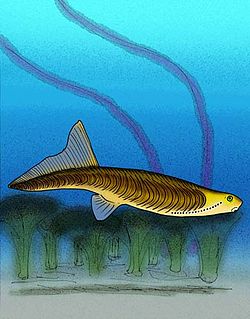Paleobiota
Arthropods
| Arthropods | |||
|---|---|---|---|
| Species | Notes | Images | |
| Slimonia acuminata | A slimonid eurypterid. |  | |
| Erettopterus bilobus | A pterygotid eurypterid. |  | |
| Selkiepterella lanceolata | An adelophthalmid eurypterid, previously a species of Nanahughmilleria . [9] | ||
| Waterstonopterus lanarkensis | A hardieopterid eurypterid, previously a species of Hardieopterus . | ||
| Loganamaraspis dunlopi | A chasmataspidid. | ||
| Cyamocephalus loganensis | A synziphosurine. |  | |
| Pseudoniscus falcatus | A synziphosurine. | ||
| Ainiktozoon loganense | A thylacocephalan. |  | |
| Ceratiocaris papilio | A phyllocarid. |  | |
Chordates
| Chordates | |||
|---|---|---|---|
| Species | Notes | Images | |
| Loganellia scotica | A loganelliid thelodont. |  | |
| Jamoytius kerwoodi | An enigmatic chordate. |  | |